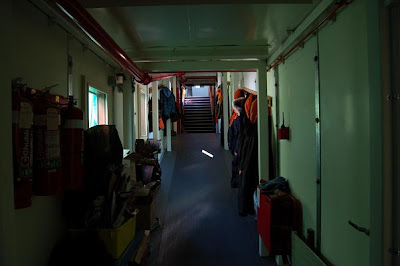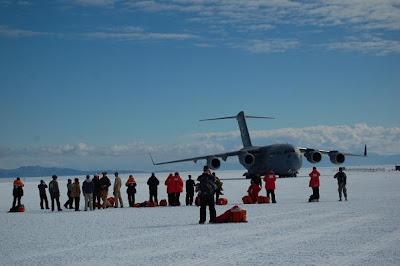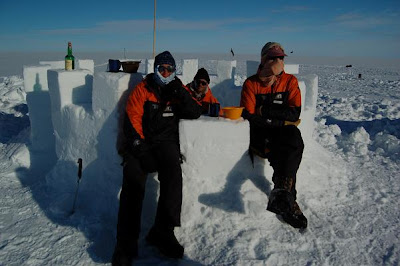 My family have been visiting from Canada for the last two months. They arrived while I was still down on the Ice and have been touring the countryside over the last six weeks with little rest (which seems to be catching up with them now). I've been able to join them on a few trips and have enjoyed being able to show them around our new home. A week after we got back from Antarctica, my parents, my brother and myself headed north to Wellington on the Transcoastal train and then up to Taumarunui by car, to paddle the longest navigable stretch of water in New Zealand - the Whanganui. After two weeks in Antarctica, the forested gorge we paddled through was teeming with life, colour and with sound. It was wonderful to be back.
My family have been visiting from Canada for the last two months. They arrived while I was still down on the Ice and have been touring the countryside over the last six weeks with little rest (which seems to be catching up with them now). I've been able to join them on a few trips and have enjoyed being able to show them around our new home. A week after we got back from Antarctica, my parents, my brother and myself headed north to Wellington on the Transcoastal train and then up to Taumarunui by car, to paddle the longest navigable stretch of water in New Zealand - the Whanganui. After two weeks in Antarctica, the forested gorge we paddled through was teeming with life, colour and with sound. It was wonderful to be back. We took the same train as when Stephen's mom was here. Heading up the East coast of the South Island to Picton where we got on the ferry and crossed the Cook straight to Wellington. The train was much more full at this time of year and the landscape was somewhat different, but much of it was the same, sheep, sheep, and more sheep. Oh and a little bit of salt too (the picture is of the New Zealand salt lakes where ~90% of our salt is produced by flooding several lakes with sea water and then letting the sun evaporate them until there is nothing but salt left).
We took the same train as when Stephen's mom was here. Heading up the East coast of the South Island to Picton where we got on the ferry and crossed the Cook straight to Wellington. The train was much more full at this time of year and the landscape was somewhat different, but much of it was the same, sheep, sheep, and more sheep. Oh and a little bit of salt too (the picture is of the New Zealand salt lakes where ~90% of our salt is produced by flooding several lakes with sea water and then letting the sun evaporate them until there is nothing but salt left). We didn't have much time in Wellington, only the afternoon of our arrival, as we left pretty early the next morning. But the ferry arrives at around 4pm, so we had a few hours to wander through the city before tucking into some dinner and going to bed. It was amazingly windy that afternoon, at one point a gust of wind actually knocked me backwards. I can't imagine what it would have been like to try and paddle in that wind.
We didn't have much time in Wellington, only the afternoon of our arrival, as we left pretty early the next morning. But the ferry arrives at around 4pm, so we had a few hours to wander through the city before tucking into some dinner and going to bed. It was amazingly windy that afternoon, at one point a gust of wind actually knocked me backwards. I can't imagine what it would have been like to try and paddle in that wind.After a dinner of pizza (the best in Wellington), we settled into bed and slept. The next day we drove north to Taumarunui where the Whanganui becomes paddleable. Kitted out with barrels, boats and paddles by our local outfitter we were set to tackle the water - and all 197 rapids in the ~200km of river we would paddle.
 The "rapids" it turns out include every rock, tree and foreign object located in the river, no matter the size. There was certainly some white water to reckon with, and mom and I did end up in some tight spots on the first day, but all in all, it was a pretty relaxed river (as you can see). Just what I needed.
The "rapids" it turns out include every rock, tree and foreign object located in the river, no matter the size. There was certainly some white water to reckon with, and mom and I did end up in some tight spots on the first day, but all in all, it was a pretty relaxed river (as you can see). Just what I needed. It was great to be with my family, sharing an adventure we have regularly enjoyed together, but in a place completly different from what any of us knows. I could identify a few plants and birds, but it was a new and exciting experience to be a place with so many new and amazing things to learn about.
It was great to be with my family, sharing an adventure we have regularly enjoyed together, but in a place completly different from what any of us knows. I could identify a few plants and birds, but it was a new and exciting experience to be a place with so many new and amazing things to learn about. The first camp site was located up on a little grassy bench in the gorge. It had phenomenal views both up and down river, and in the middle of the night a thunder storm pelted us with rain. We woke up to a misty river and a landscape of vibrant greens, echoing with bellbirds and tuis.
The first camp site was located up on a little grassy bench in the gorge. It had phenomenal views both up and down river, and in the middle of the night a thunder storm pelted us with rain. We woke up to a misty river and a landscape of vibrant greens, echoing with bellbirds and tuis. The Whanganui River flows through a deep gorge, carved into the lava flows from thousands of years ago. The walls of the gorge are pock-marked with caverns, caves and holes of varying size and shape. The river is also in the home of several Maori iwis, with marae dotted along the river shore like mile posts - only you need to know where to look. We saw one, and it, Tieke Marae, was only visible due to the ~160 maori camped there on their annual journey to learn and pass along knowledge to the next generation.
The Whanganui River flows through a deep gorge, carved into the lava flows from thousands of years ago. The walls of the gorge are pock-marked with caverns, caves and holes of varying size and shape. The river is also in the home of several Maori iwis, with marae dotted along the river shore like mile posts - only you need to know where to look. We saw one, and it, Tieke Marae, was only visible due to the ~160 maori camped there on their annual journey to learn and pass along knowledge to the next generation. Despite the lack of charismatic megafauna (the only "wildlife" we saw were some feral goats and one owl - a morpork), we did find some other cool critters. This is a baby cicada sitting on my thumb. They grow up to about double this size, but no matter how big they are, the sound they make is huge. Everywhere here in the summer, the trees almost vibrate with their chirping.
Despite the lack of charismatic megafauna (the only "wildlife" we saw were some feral goats and one owl - a morpork), we did find some other cool critters. This is a baby cicada sitting on my thumb. They grow up to about double this size, but no matter how big they are, the sound they make is huge. Everywhere here in the summer, the trees almost vibrate with their chirping. The weather on our trip was pretty good. Not great (ie., not nearly warm enough), but good enough. Mostly sunny, we did get one good deluge of rain, but the afternoon sun dried us off and warmed us up (mostly).
The weather on our trip was pretty good. Not great (ie., not nearly warm enough), but good enough. Mostly sunny, we did get one good deluge of rain, but the afternoon sun dried us off and warmed us up (mostly). These narrow side gorges brought in tiny streams of water and drew you into them to see where their winding passages ended up. It was fun to stop and claw your way up the passages, filled with cool, deep water and cool, deeper mud. Unfortunately it wasn't quite hot enough to think about swimming up some of the deeper streams, but we did get in quite a ways.
These narrow side gorges brought in tiny streams of water and drew you into them to see where their winding passages ended up. It was fun to stop and claw your way up the passages, filled with cool, deep water and cool, deeper mud. Unfortunately it wasn't quite hot enough to think about swimming up some of the deeper streams, but we did get in quite a ways. The Whanganui River is considered one of New Zealand's great walks (go figure). This means it can get really, really busy. We got really, really lucky. The group we essentially traveled with included ourselves, a couple from Germany and a couple from England, seven people in all. This is compared to the 70 people one day ahead of us and the 50 behind us. We felt pretty lucky when we learned this and thoroughly enjoyed eachothers company along the way.
The Whanganui River is considered one of New Zealand's great walks (go figure). This means it can get really, really busy. We got really, really lucky. The group we essentially traveled with included ourselves, a couple from Germany and a couple from England, seven people in all. This is compared to the 70 people one day ahead of us and the 50 behind us. We felt pretty lucky when we learned this and thoroughly enjoyed eachothers company along the way. The trip was wonderful. An absolutely gorgeous environment to be in, rich with plants, with birds and with history, the Whanganui River does not disappoint. I can't wait to bring Stephen up here and share it with him. There is just nothing like paddling through 40-50 metre high gorges reverberating with the calls of birds and the sound of waterfalls trickling down ancient, hidden gorges.
The trip was wonderful. An absolutely gorgeous environment to be in, rich with plants, with birds and with history, the Whanganui River does not disappoint. I can't wait to bring Stephen up here and share it with him. There is just nothing like paddling through 40-50 metre high gorges reverberating with the calls of birds and the sound of waterfalls trickling down ancient, hidden gorges.







































